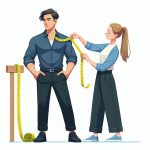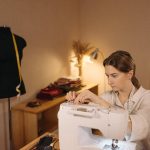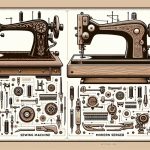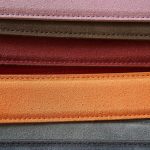Do you enjoy sewing clothes and creating unique designs? If so, you may have heard of an overlock machine.
An overlock machine is a type of sewing machine that is used to create clean and professional-looking edges on fabric. With an overlock machine, you can easily finish seams, hem garments, and create decorative edges.
It is a versatile tool that can save you a lot of time and effort compared to finishing edges by hand. In this article, we will explore what an overlock machine is, how it works, and the benefits of using one in your sewing projects.
So, let’s dive in and learn more about this amazing tool!
Table of Contents
Definition of an Overlock Machine
If you’re looking for a machine that can sew and finish seams all in one go, you’ll love an overlock machine!
An overlock machine is a specialized sewing machine that is designed to sew over the edge of one or two pieces of cloth to create neat, finished edges. It is also used to join seams together and trim off excess fabric at the same time.
An overlock machine works by using multiple threads to create a strong, reinforced seam. It has multiple needles and loopers that work together to create a stitch that wraps around the edge of the fabric, preventing fraying and unraveling. The machine can be adjusted to create different stitch lengths and widths, depending on the fabric and the desired effect.
Overlock machines are often used in garment making and other textile industries, where speed and efficiency are essential. They can also be used by home sewers who want to create professional-looking finished edges on their projects.
With an overlock machine, you can create finished seams on a variety of fabrics, from lightweight silks to heavy denim, with ease and precision.
How an Overlock Machine Works
When you’re sewing a seam, have you ever noticed the edges fraying and unraveling? That’s where a handy tool like an overlock machine comes in to save the day!
An overlock machine works by trimming the edges of the fabric as it sews, which creates a neat and professional finish. Here’s how it works:
The overlock machine has multiple needles and loopers that work together to sew and trim at the same time. As the fabric moves through the machine, it passes over a set of knives that trim the edges evenly and prevent fraying.
The needles and loopers then stitch over the trimmed edges, creating a strong seam that won’t unravel. Depending on the type of overlock machine, you can adjust the settings to create different types of stitches, such as a narrow or wide overlock, or a flatlock stitch for joining two pieces of fabric without a seam allowance.
Overall, an overlock machine is an essential tool for anyone who wants to achieve a professional finish on their sewing projects. It saves time and effort by trimming and sewing at the same time, and it produces a clean and tidy edge that won’t fray or unravel. If you’re serious about sewing, investing in an overlock machine is definitely worth considering!
Benefits of Using an Overlock Machine
One of the best things about using an overlock machine is how it can transform your projects from homemade to professional-looking with ease. This is because an overlock machine can create clean and finished edges on fabric, which is especially useful when making clothes or other items that require a polished look. With an overlock machine, you can avoid the frayed edges and loose threads that can make a project look amateurish.
Another benefit of using an overlock machine is that it can save you time. Because an overlock machine can sew and finish edges in one step, you can complete projects much faster than if you were to sew and finish edges separately. This is especially helpful if you’re working on a large project or if you want to finish a project quickly.
An overlock machine can also save you money in the long run. While it can be a significant investment upfront, it can pay for itself over time. By using an overlock machine to finish edges, you can extend the life of your projects and avoid having to replace them as frequently. Additionally, by creating professional-looking projects, you may be able to sell your work for more money than if you were to create homemade-looking projects.
Choosing the Right Overlock Machine
When it comes to choosing the right overlock machine, there are a few things you should keep in mind.
For home sewers, you’ll want to consider factors like ease of use and affordability.
Professionals, on the other hand, may be more concerned with speed, durability, and advanced features.
Considerations for Home Sewers
For a cozy and professional-looking finish on your homemade garments, an overlock machine is a must-have investment for any home sewer. When choosing an overlock machine for home use, consider the features that are most important to you.
For example, if you plan on using your machine frequently, look for a model that is durable and can handle heavy use. Additionally, look for a machine that is easy to thread and adjust, as this will save you time and frustration in the long run.
Another consideration for home sewers is the size of the machine. If you have limited space in your home sewing area, look for a compact and lightweight machine that can be easily stored when not in use. However, if you plan on working on larger projects such as quilts or curtains, a larger machine may be necessary to accommodate the size of the fabric.
By taking these factors into account, you can find the perfect overlock machine for your home sewing needs.
Considerations for Professionals
As a professional, it’s important to carefully consider the features and size of the equipment you invest in to ensure maximum efficiency and productivity in your sewing workspace.
When it comes to overlock machines, you want to look for models that can handle heavy-duty use and high volumes of work. Features like automatic tension control and differential feed can help you achieve clean, professional-looking seams on a variety of fabrics.
Additionally, as a professional, you may want to consider investing in a larger overlock machine with multiple needles and threads. This can allow you to complete more complex projects with multiple layers of fabric, such as upholstery or drapery.
It’s also important to choose a machine with a durable construction and easy-to-use controls, as you’ll likely be using it frequently and for long periods of time.
By carefully considering your needs and investing in a high-quality overlock machine, you can ensure that your sewing work is efficient, productive, and of the highest quality.
Setting up Your Overlock Machine
First, you’ll need to position your overlock machine on a sturdy surface with enough room for your fabric to flow freely. Make sure the machine is level and stable, and that there is enough space around it for you to move comfortably.
You’ll also want to make sure that the machine is plugged in and turned on, and that any necessary adjustments have been made to the tension, stitch length, and other settings.
Next, you’ll need to thread your overlock machine properly. This can be a bit tricky, but it’s an essential step if you want your machine to work correctly. Follow the instructions in your machine’s manual carefully, and make sure that each thread is threaded through the correct guides and tension discs. Be patient and take your time, as this is a crucial step that will impact the quality of your finished product.
You’ll need to test your machine before you start sewing. This will help you identify any issues or problems before you begin your project, and ensure that everything is working as it should be. Use a scrap piece of fabric and run it through the machine to check the stitch quality, tension, and other settings. Make any necessary adjustments before you start your actual project, and you’ll be well on your way to creating beautiful, professional-quality seams and finishes.
Tips for Using an Overlock Machine
One helpful tip when using an overlock machine is to keep a scrap piece of fabric nearby to test your stitches before starting on your actual project. This will help you make any necessary adjustments to the tension or stitch length before you accidentally ruin your project.
It’s also a good idea to keep a few different types of fabric scraps on hand, as different materials may require different settings on your machine.
Another important tip for using an overlock machine is to make sure you have enough thread to complete your project. Running out of thread mid-project can be frustrating and time-consuming, so always check your thread supply before you start.
Additionally, it’s a good practice to change your needles regularly. Dull needles can cause uneven stitches or even damage your fabric.
When using an overlock machine, it’s important to pay attention to your speed and technique. Going too fast or not guiding your fabric properly can result in uneven or skipped stitches. Take your time and practice on scrap fabric before moving on to your actual project.
With a little patience and practice, you’ll be able to use your overlock machine to create beautiful, professional-looking seams and edges.
- Tetron Fabric for Marine Applications: Durability and Use Cases - June 18, 2025
- Tetron Fabric for Outdoor Furniture: Weather Resistance and Care - June 18, 2025
- Tetron Fabric for Wall Coverings: Style and Application Tips - June 18, 2025






